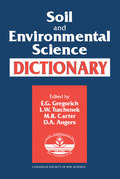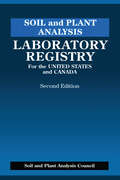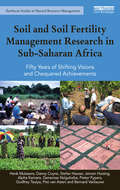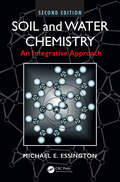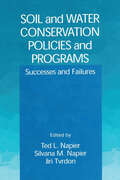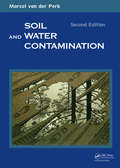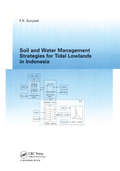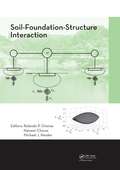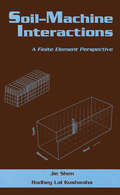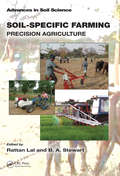- Table View
- List View
Soil and Environmental Science Dictionary
by E. G. Gregorich L. W. Turchenek M. R. Carter D. A. AngersThe lingo of soil science is a language unto itself. Soil and Environmental Science Dictionary is a glossary of terms used in soil and environmental science, including terms from related disciplines. Designed for teachers, students, researchers and others interested or involved in environmental sciences related to soils, this compilation includes a
Soil and Fertilizers: Managing the Environmental Footprint (Advances in Soil Science)
by Rattan LalSoil and Fertilizers: Managing the Environmental Footprint presents strategies to improve soil health by reducing the rate of fertilizer input while maintaining high agronomic yields. It is estimated that fertilizer use supported nearly half of global births in 2008. In a context of potential food insecurity exacerbated by population growth and climate change, the importance of fertilizers in sustaining the agronomic production is clear. However, excessive use of chemical fertilizers poses serious risks both to the environment and to human health. Highlighting a tenfold increase in global fertilizer consumption between 2002 and 2016, the book explains the effects on the quality of soil, water, air and biota from overuse of chemical fertilizers. Written by an interdisciplinary author team, this book presents methods for enhancing the efficiency of fertilizer use and outlines agricultural practices that can reduce the environmental footprint. Features: Includes a thorough literature review on the agronomic and environmental impact of fertilizer, from degradation of ecosystems to the eutrophication of drinking water Devotes specific chapters to enhancing the use efficiency and effectiveness of the fertilizers through improved formulations, time and mode of application, and the use of precision farming technology Reveals geographic variation in fertilizer consumption volume by presenting case studies for specific countries and regions, including India and Africa Discusses the pros and cons of organic vs. chemical fertilizers, innovative technologies including nuclear energy, and the U.N.’s Sustainable Development Goals Part of the Advances in Soil Sciences series, this solutions-focused volume will appeal to soil scientists, environmental scientists and agricultural engineers.
Soil and Groundwater Remediation Technologies: A Practical Guide
by Yong Sik Ok; Jörg Rinklebe; Deyi Hou; Daniel C.W. Tsang; Filip M.G. TackThis book offers various soil and water treatment technologies due to increasing global soil and water pollution. In many countries, the management of contaminated land has matured, and it is developing in many others. Topics covered include chemical and ecological risk assessment of contaminated sites; phytomanagement of contaminants; arsenic removal; selection and technology diffusion; technologies and socio-environmental management; post-remediation long-term management; soil and groundwater laws and regulations; and trace element regulation limits in soil. Future prospects of soil and groundwater remediation are critically discussed in this book. Hence, readers will learn to understand the future prospects of soil and groundwater contaminants and remediation measures.Key Features: Discusses conventional and novel aspects of soil and groundwater remediation technologies Includes new monitoring/sensing technologies for soil and groundwater pollution Features a case study of remediation of contaminated sites in the old, industrial, Ruhr area in Germany Highlights soil washing, soil flushing, and stabilization/solidification Presents information on emerging contaminants that exhibit new challenges This book is designed for undergraduate and graduate courses and can be used as a handbook for researchers, policy makers, and local governmental institutes. Soil and Groundwater Remediation Technologies: A Practical Guide is written by a team of leading global experts in the field.
Soil and Groundwater Remediation: Fundamentals, Practices, and Sustainability
by Chunlong ZhangAn introduction to the principles and practices of soil and groundwater remediation Soil and Groundwater Remediation offers a comprehensive and up-to-date review of the principles, practices, and concepts of sustainability of soil and groundwater remediation. The book starts with an overview of the importance of groundwater resource/quality, contaminant sources/types, and the scope of soil and groundwater remediation. It then provides the essential components of soil and groundwater remediation with easy-to-understand design equations/calculations and the practical applications. The book contains information on remediation basics such as subsurface chemical behaviors, soil and groundwater hydrology and characterization, regulations, cost analysis, and risk assessment. The author explores various conventional and innovative remediation technologies, including pump-and-treat, soil vapor extraction, bioremediation, incineration, thermally enhanced techniques, soil washing/flushing, and permeable reactive barriers. The book also examines the modeling of groundwater flow and contaminant transport in saturated and unsaturated zones. This important book: Presents the current challenges of remediation practices Includes up-to-date information about the low-cost, risk-based, sustainable remediation practices, as well as institutional control and management Offers a balanced mix of the principles, practices, and sustainable concepts in soil and groundwater remediation Contains learning objectives, discussions of key theories, and example problems Provides illustrative case studies and recent research when remediation techniques are introduced Written for undergraduate seniors and graduate students in natural resource, earth science, environmental science/engineering, and environmental management, Soil and Groundwater Remediation is an authoritative guide to the principles and components of soil and groundwater remediation that is filled with worked and practice problems.
Soil and Plant Analysis: Laboratory Registry for the United States and Canada, Second Edition
by J. Benton Jones Jr.With the renewed current emphasis on agricultural production efficiency and environmental quality, the technology of soil and plant analysis has taken on even greater importance. Several states now require soil testing as part of their nutrient management programs. Soil testing and plant analysis are important components of the Food Security Act and under consideration as safeguards for the new Clean Water Act. The Council on Soil Testing and Plant Analysis, established in 1969, promotes soil testing and plant analysis, including efficient use of nutrient resources, maximizing profits, and encouraging proper soil management and environmental protection. Compiled by the Council in response to the growing need for information about soil testing and plant analysis laboratories, Soil and Plant Analysis Laboratory Registry for the United States and Canada, Second Edition provides up-to-date information about public and private laboratory services, including:
Soil and Recycling Management in the Anthropocene Era (Environmental Science and Engineering)
by Gero BenckiserThis book discusses soil and recycling management in the Anthropocene era. Nitrogen shortage is one of nature’s most important productivity regulators, but since the advent of technical nitrogen fixation (TNF), biological nitrogen fixation (BNF) input has nearly doubled, particularly in grass and arable lands covering over 13 million km2 of the Earth’s surface. This book explores how monoculture grass, arable lands and forests are often over fertilized with TNF, animal slurries, sewage sludge, or municipally produced composts, and as a result, flora and fauna that have adapted to a nitrogen shortage in the soil will have to adjust to a surplus; those that are unable to adapt will disappear.
Soil and Rock Construction Materials
by Greg McNallyAn introduction to the investigation, extraction, processing and specification of natural soil and rock materials, with an emphasis on why particular material properties are sought and how they may be modified. The book covers the full range of soil and rock construction materials including crushed stone, sand and gravel, natural and prepared roadb
Soil and Soil Fertility Management Research in Sub-Saharan Africa: Fifty years of shifting visions and chequered achievements (Earthscan Studies in Natural Resource Management)
by Bernard Vanlauwe Generose Nziguheba Danny Coyne Henk Mutsaers Stefan Hauser Jeroen Huising Alpha Kamara Pieter Pypers Godfrey Taulya Piet van AstenJudicious soil fertility management is crucial for sustainable crop production and food security in sub-Saharan Africa (SSA). This book describes the various concepts and approaches underlying soil and soil fertility management research in SSA over the last fifty years. It provides examples of important innovations generated and assesses the position of research within the research-to-development continuum, including how innovations have been validated with the intended beneficiaries. Using the experience of the International Institute of Tropical Agriculture (IITA) as a case study, the authors analyse how processes, partnerships and other factors have affected research priorities, the delivery of outputs, and their uptake by farming communities in SSA. They evaluate both successes and failures of past investments in soil fertility research and important lessons learnt which provide crucial information for national and international scientists currently engaged in this research area. The book is organised in a number of chapters each covering a chronological period characterised by its primary research content and approaches and by the dominant research paradigms and delivery models.
Soil and Water Chemistry: An Integrative Approach, Second Edition
by Michael E. EssingtonThe second edition of a bestseller, Soil and Water Chemistry: An Integrative Approach maintains the balanced perspective that made the first edition a hugely popular textbook. The second edition includes new figures and tables, new chapters, and expanded exercises in each chapter. It covers topics including soil chemical environment, soil minerals,
Soil and Water Conservation Handbook: Policies, Practices, Conditions, and Terms
by Paul W. UngerSave time and effort with this practical guide to all aspects of water and soil conservation Soil and Water Conservation Handbook is a concise, compact encyclopedia of the policies, practices, conditions, and terms related to soil and/or water conservation. This handy A-to-Z guide contains descriptions of more than 700 entries, presente
Soil and Water Conservation Policies and Programs: Successes and Failures
by Ted L. Napier Silvana M. Napier Jiri TvrdonFor as far into the future as we can see, governments will probably topple, power will continue to exchange hands, the climate will undergo continuous change, and the global economy will ebb and flow like the oceans. But for the world's many diverse countries-whether they be highly industrialized or third world-one thing will always remain constant: the need to solve the planet's pressing soil and water conservation problems, as well as implement effective policies. But why do some policy initiatives succeed while others fail? Soil and Water Conservation Policies and Programs: Successes and Failures addresses this very question. Based on an international conference held in Prague, this book debates the strengths and weaknesses of soil and water conservation initiatives implemented in North America, Europe, and Australia. Soil and water conservation policies in the United States, Canada, Germany, Austria, Yugoslavia, and other countries are examined through the eyes of technical and soil scientists. And the book also addresses specialized topics, such as agricultural pollution abatement in Poland, and private farmers and contemporary conservation subsidy programs in the Czech Republic. With its thorough treatment of the subject matter, Soil and Water Conservation Policies and Programs: Successes and Failures contributes to resolving one of the world's most pressing conservation issues.
Soil and Water Conservation Structures Design (Water Science and Technology Library #123)
by Rajendra SinghThe book is designed to serve as a textbook for graduate and undergraduate courses on soil and water conservation engineering for students of agricultural engineering, civil engineering, environmental engineering and related disciplines. The book presents the basics of soil and water erosion, and describes the measures to control erosion, focusing on structures to prevent and control erosion. The chapters dedicated to erosion control structures provide a detailed view of each structural construction, covering the function, design and elements of each type of structure. Some common type of structures covered in the book are terrace, bunds, vegetated waterways, and gully control structures, including spillways. The book also covers wind erosion and control structures to prevent wind erosion. Each chapter includes pedagogical elements such as examples, practice questions, and multiple-choice-type questions to improve understanding and aid in self-study. Besides serving as a textbook university coursework, the book can also serve as a supplementary or primary text for professional development courses for practicing engineers engaged in soil and water conservation or watershed management. The book will also serve as a reference for professionals, environmental consultants, and policy makers engaged in soil and water conservation related fields.
Soil and Water Conservation for Sustainable Food Production (SpringerBriefs in Molecular Science)
by Subhabrata PandaThis book addresses the impact of soil and water quality on food production, and explores soil and water conservation measures to be applied at farm level for agricultural sustainability. Divided into 8 chapters, the book covers topics such as soil properties responsible for soil loss, the impact of climate change, water and biological factors on soil chemistry, the effect of soil on the quality of water including sustaining aquaculture productivity and environment of wetlands, soil and water qualities necessary for irrigation, management of soil organic carbon, and the importance of soil moisture conservation including agroforestry for food production. Particular attention is given to the management of soil organic carbon in sustainable crop cultivation as well as reducing soil erosion and nutrient loss from soil from cultivated lands. The book concludes with a chapter that integrates soil and water conservation with sustainable food production and food safety.
Soil and Water Contamination
by Marcel van PerkSoil and Water Contamination, Second Edition gives a structured overview of transport and fate processes of environmental contaminants. Providing a structured overview of transport and fate processes of environmental contaminants, this textbook approaches the environmental issues of soil and water contamination from a spatial and earth science point of view. The new edition contains new material on pesticides and pharmaceutical contaminants and a greater number of exercises, case studies, and examples. It covers topics essential to understanding and predicting contaminant patterns in soil, groundwater, and surface water and contributes to the formation of a solid basis for adequate management and control of soil and water pollution and integrated catchment.
Soil and Water Management Strategies for Tidal Lowlands in Indonesia
by Fransiscus Xaverius SuryadiThis book presents a methodology to support the development of soil and water management strategies for tidal lowlands in general and Indonesian tidal lowlands in particular. It analyzes and evaluates the potential of tidal lowlands for agricultural development.
Soil as World Heritage
by David DentSoil as World Heritage celebrates a half century of field experiments on the Balti Steppe, in Moldova - where Dokuchaev first described the Typical Chernozem in 1877, protected from the elements by a unique system of shelter belts designed by the great man, and now provisionally listed as the first World Heritage Site for soil. The book presents contributions to the 2012 international symposium attended by researchers, practitioners and policy makers from the European Commission and countries as diverse as Belarus, Bulgaria, the Czech Republic, France, Germany, Italy , the Netherlands, Romania, Russia, Ukraine, United Kingdom, USA and, of course, Moldova itself. The experimental data demonstrate the damage caused by human activity to the productivity and integrity of the black earth and, also, ways to restore its fertility. Results from even longer-established trials worldwide also demonstrate that agricultural practices are driving global warming, leaching of nutrients, pollution of water resources, diversion of rainfall away from replenishment of soil and groundwater to destructive runoff, and destroying soil organic matter and biodiversity. These are pressing issues for our generation and will press harder on future generations. Long-term field experiments, and the scientific skills and experience that they nurture, will be more and more valuable as a foundation and focus for interdisciplinary teams studying the effects of farming practices on the soil and soil life so as to devise a sustainable alternative. Europe-wide and worldwide contributions also discuss economic incentives - carbon and green water credits - which themselves require robust supporting data, and legislative aspects of promoting more sustainable farming systems. The outcomes of the conference include recommendations for institutional support for sustainable farming and a draft of the law on land and soil management for the Parliament of Moldova.
Soil behaviour and critical state soil mechanics
by David Muir WoodSoils can rarely be described as ideally elastic or perfectly plastic and yet simple elastic and plastic models form the basis for the most traditional geotechnical engineering calculations. With the advent of cheap powerful computers the possibility of performing analyses based on more realistic models has become widely available. One of the aims of this book is to describe the basic ingredients of a family of simple elastic-plastic models of soil behaviour and to demonstrate how such models can be used in numerical analyses. Such numerical analyses are often regarded as mysterious black boxes but a proper appreciation of their worth requires an understanding of the numerical models on which they are based. Though the models on which this book concentrates are simple, understanding of these will indicate the ways in which more sophisticated models will perform.
Soil in Criminal and Environmental Forensics
by Henk Kars Lida EijkelThis introductory volume to a new series on Soil Forensics gives a kaleidoscopic view of a developing forensic expertise. Forensic practitioners and academic researchers demonstrate, by their joint contributions, the extent and complexity of soil forensics. their reports exemplify the broad range of sciences and techniques applied in all stages of forensic soil examinations, from investigations at crime scenes to providing evidence that can be used in court proceedings. Moreover the necessity is depicted of co-operation as a condition for any work in soil forensics between scientists of different disciplines, but no less between scientists and law enforcers. Soils play a role in environmental crimes and liability, as trace evidence in criminal investigations and, when searching for and evaluating, buried human remains. This book shows soil forensics as practiced in this legal context, emerging and solidifying in many countries all over the world, differing in some respects because of differences in legal systems but ultimately sharing common grounds.
Soil mechanics
by David Muir WoodThis 2009 book teaches the principles of soil mechanics to undergraduates, along with other properties of engineering materials, to which the students are exposed simultaneously. Using the critical state method of soil mechanics to study the mechanical behavior of soils requires the student to consider density alongside effective stresses, permitting the unification of deformation and strength characteristics. This unification aids the understanding of soil mechanics. This book explores a one-dimensional theme for the presentation of many of the key concepts of soil mechanics - density, stress, stiffness, strength, and fluid flow - and includes a chapter on the analysis of one-dimensional consolidation, which fits nicely with the theme of the book. It also presents some theoretical analyses of soil-structure interaction, which can be analyzed using essentially one-dimensional governing equations. Examples are given at the end of most chapters, and suggestions for laboratory exercises or demonstrations are given.
Soil to Foil: Aluminum and the Quest for Industrial Sustainability
by Saleem AliAluminum is the most abundant metal in the earth’s crust. It is also ubiquitous in the modern world, from aircraft to soda cans. A dizzying number of consumer and industrial products employ aluminum, typically alloyed, because of its availability, versatility, and malleability. Today, how efficiently we use—and reuse—aluminum is vital to addressing key environmental challenges and understanding humanity’s fraught relationship with the earth.Soil to Foil tells the extraordinary story of aluminum. Saleem H. Ali reveals its pivotal role in the histories of scientific inquiry and technological innovation as well as its importance to sustainability. He offers compelling portraits of the scientists and innovators who discovered new uses for this remarkable element, ranging from chemistry and geoscience to engineering and industrial design. Ali argues that aluminum exemplifies broader lessons about stewardship of nonrenewable resources: its seeming abundance has given rise to wasteful and destructive practices. Soil to Foil follows aluminum’s path along the supply chain, from extraction to production, consumption to recycling. Ali explores the ecological damage at mine sites and visits affected communities seeking to restore the land. He foregrounds the possibilities for more sustainable industrial practices, emphasizing how product design can incorporate eventual reuse and recycling. Ultimately, Soil to Foil shows that the story of aluminum’s use and misuse helps us rethink how to sustainably manage the resources of our planet.
Soil, Plant and Atmosphere: Concepts, Processes and Applications
by Klaus Reichardt Luís Carlos TimmThis textbook presents the concepts and processes involved in the soil-plant-atmosphere system as well as its applications in the water cycle in agriculture. Although reaching the frontier of our knowledge in several subjects, each chapter starts at the graduation level and proceeds to the post-doctoral level. Its more complicated subjects, as math and physics, are well explained, even to readers not well acquainted with these tools. Therefore, it helps students read, understand, and developing their thoughts on these subjects. Instructors also find it an easy book with the needed depth to be adopted in courses related to Soil Physics, Agricultural Management, Environmental Protection, Irrigation and Agrometeorology. It serves also as “lexicon” to engineers and lawyers involved in agricultural, environmental cases.
Soil, Water Pollution and Mitigation Strategies: A Spatial Approach (Environmental Science and Engineering)
by Pravat Kumar Shit Partha Pratim Adhikary Jayasree LahaDive into the dynamic world of environmental stewardship with "Soil, Water Pollution, and Mitigation Strategies: A Spatial Approach." This meticulously crafted volume offers a comprehensive journey through the measurement, monitoring, mapping, and modelling of soil and water pollution, coupled with innovative mitigation strategies. Discover cutting-edge techniques rooted in modern geospatial methodologies, with a sharp focus on the latest trends in data mining and robust modelling. As our planet grapples with the consequences of anthropogenic activities, such as indiscriminate chemical usage in agriculture, the need for precise quantification and risk assessment has never been more urgent. This book serves as a beacon, illuminating the path toward sustainable management of soil and water resources through the lens of geospatial technology. Explore a myriad of critical topics, including soil microbiology, salinity, pollution from industrial sources, heavy metals, and the pervasive impact of agricultural practices. Delve into environmental risk assessment, sustainable land use, and innovative remediation techniques, such as harnessing the power of Plant Growth-Promoting Rhizobacteria (PGPR) and embracing organic fertilizers. Written for researchers, professionals, and policymakers alike, this book offers invaluable insights into the complex interplay between human activity and environmental health. Organized into two parts (I) Soil Contaminants, Risk Assessment, and Mitigation, and (II) Water Contaminants, Risk Assessment, and Mitigation—it provides a structured approach to understanding and addressing environmental challenges. Each chapter serves as a portal to a deeper understanding of the issues at hand, presenting a synthesis of current research, identifying future directions, and offering pragmatic solutions. This book promises to enrich the understanding of environmental science and empower the reader with the knowledge and skills needed to effect positive change. Designed to cater to a diverse audience—from students and researchers in environmental sciences to policymakers, NGOs, and corporate stakeholders—this book is a testament to the collaborative effort required to safeguard our planet's precious resources. This is a transformative journey toward a more sustainable future—one informed by science, guided by innovation, and driven by a shared commitment to environmental stewardship.
Soil-Foundation-Structure Interaction: A Special Issue Of The International Journal Of Human-computer Interaction
by James R. LewisSoil-Foundation-Structure Interaction contains selected papers presented at the International Workshop on Soil-Foundation-Structure Interaction held in Auckland, New Zealand from 26-27 November 2009. The workshop was the venue for an international exchange of ideas, disseminating information about experiments, numerical models and practical en
Soil-Machine Interactions: A Finite Element Perspective
by ShenAiming to improve work efficiency in such areas as tillage in agriculture, earth-moving in civil engineering, and tunnel-making in sea-bed operations, this work offers an introduction to Finite Element Method (FEM) analysis of soil-machine systems. It explains the advantage of FEM's numerical approach over traditional analytical and empirical methods of dealing with complex factors from nonlinear mechanical behaviour to geometric configurations.
Soil-Specific Farming: Precision Agriculture (Advances in Soil Science)
by Rattan Lal B. A. StewartFaced with challenges of resource scarcity and environmental degradation, it is important to adopt innovative farming systems that maximize resource efficiency while protecting the environment. Soil-Specific Farming: Precision Agriculture focuses on principles and applications of soil-specific farming, providing information on rapidly evolving agri
